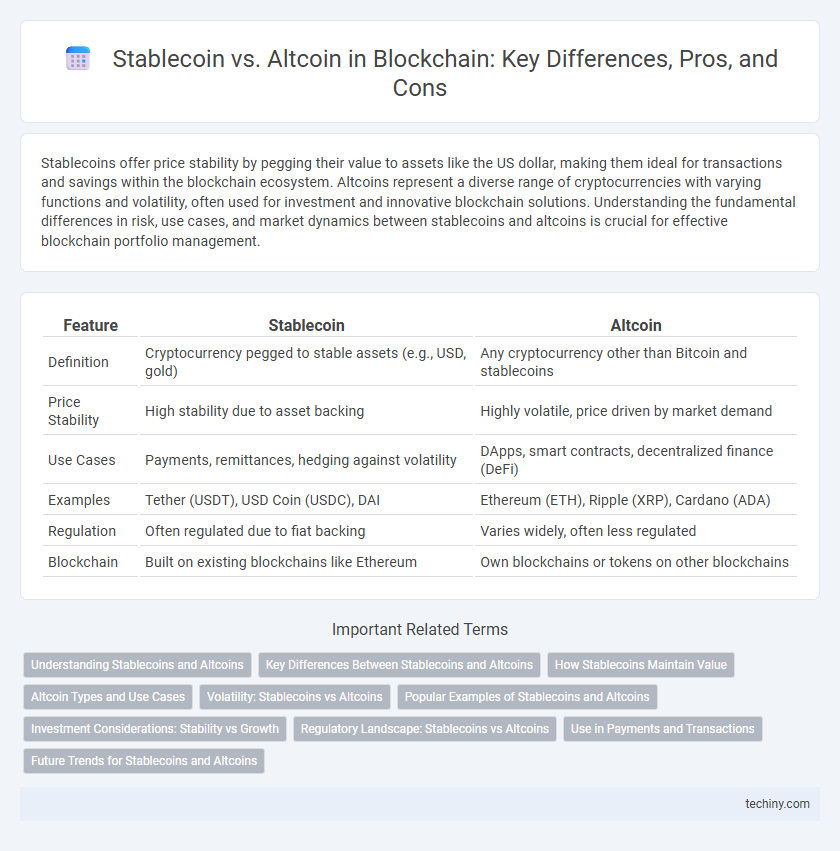Stablecoins offer price stability by pegging their value to assets like the US dollar, making them ideal for transactions and savings within the blockchain ecosystem. Altcoins represent a diverse range of cryptocurrencies with varying functions and volatility, often used for investment and innovative blockchain solutions. Understanding the fundamental differences in risk, use cases, and market dynamics between stablecoins and altcoins is crucial for effective blockchain portfolio management.
Table of Comparison
| Feature | Stablecoin | Altcoin |
|---|---|---|
| Definition | Cryptocurrency pegged to stable assets (e.g., USD, gold) | Any cryptocurrency other than Bitcoin and stablecoins |
| Price Stability | High stability due to asset backing | Highly volatile, price driven by market demand |
| Use Cases | Payments, remittances, hedging against volatility | DApps, smart contracts, decentralized finance (DeFi) |
| Examples | Tether (USDT), USD Coin (USDC), DAI | Ethereum (ETH), Ripple (XRP), Cardano (ADA) |
| Regulation | Often regulated due to fiat backing | Varies widely, often less regulated |
| Blockchain | Built on existing blockchains like Ethereum | Own blockchains or tokens on other blockchains |
Understanding Stablecoins and Altcoins
Stablecoins are digital currencies pegged to stable assets like the US dollar or gold, providing price stability and reducing volatility typical of cryptocurrencies. Altcoins refer to all cryptocurrencies other than Bitcoin, including Ethereum, Ripple, and Litecoin, often featuring diverse use cases and varying degrees of decentralization and technological innovation. Understanding the fundamental differences between stablecoins and altcoins is crucial for investors seeking risk management or diversification within the blockchain ecosystem.
Key Differences Between Stablecoins and Altcoins
Stablecoins maintain a fixed value by being pegged to assets like fiat currencies, providing stability and reducing volatility in transactions. Altcoins, representing all cryptocurrencies other than Bitcoin and stablecoins, often feature varied use cases, technological innovations, and higher price fluctuations. The primary difference lies in stablecoins' purpose as a medium of exchange with price stability versus altcoins' roles in decentralization, smart contracts, or specific ecosystem utilities.
How Stablecoins Maintain Value
Stablecoins maintain value by pegging their price to stable assets such as fiat currencies or commodities through collateral reserves or algorithmic mechanisms. This pegging reduces price volatility compared to altcoins whose values fluctuate based on market demand and speculation. By providing liquidity stability, stablecoins enable seamless transactions and serve as reliable mediums of exchange and stores of value within the blockchain ecosystem.
Altcoin Types and Use Cases
Altcoins encompass a wide variety of blockchain-based tokens excluding Bitcoin, including Ethereum, Ripple (XRP), and Litecoin, each designed with unique functionalities and consensus mechanisms. Use cases span decentralized finance (DeFi) applications, smart contract platforms, cross-border payments, and non-fungible tokens (NFTs), enabling diverse financial and technological innovations beyond stablecoins' focus on price stability. This versatility in altcoin types supports specialized blockchain solutions tailored to different industries and user needs.
Volatility: Stablecoins vs Altcoins
Stablecoins maintain price stability by being pegged to assets like the US dollar, minimizing volatility and providing a reliable medium of exchange in the blockchain ecosystem. In contrast, altcoins exhibit significant price fluctuations driven by market speculation, technological developments, and adoption rates, which can result in high volatility. This volatility impacts investor risk tolerance and use cases, making stablecoins ideal for transactions and altcoins suited for investment and innovation exposure.
Popular Examples of Stablecoins and Altcoins
Popular examples of stablecoins include Tether (USDT), USD Coin (USDC), and Binance USD (BUSD), which are pegged to fiat currencies to minimize price volatility. Leading altcoins comprise Ethereum (ETH), Binance Coin (BNB), and Cardano (ADA), known for their diverse use cases and smart contract capabilities. The distinction between stablecoins and altcoins lies in stability versus innovation, with stablecoins providing consistent value and altcoins offering decentralized applications and ecosystem growth.
Investment Considerations: Stability vs Growth
Stablecoins offer investors a reliable store of value with minimal price volatility, making them ideal for preserving capital and facilitating transactions within the blockchain ecosystem. Altcoins, conversely, present higher growth potential but come with increased market risk and price fluctuations, appealing to investors seeking substantial returns through speculative opportunities. Evaluating the trade-off between the stability of stablecoins and the growth prospects of altcoins is crucial for strategic portfolio diversification in cryptocurrency investments.
Regulatory Landscape: Stablecoins vs Altcoins
Stablecoins face stricter regulatory scrutiny due to their pegged value and potential impact on financial stability, leading to requirements such as reserve audits and compliance with anti-money laundering (AML) laws. Altcoins, with higher volatility and diverse use cases, remain under more decentralized regulatory frameworks, often categorized as securities or utility tokens based on their functions. Regulatory agencies continue to evolve guidelines to address risks associated with both, balancing innovation with investor protection.
Use in Payments and Transactions
Stablecoins offer a significant advantage in payments and transactions by providing price stability, reducing volatility risks commonly associated with altcoins. Altcoins, while diverse in functionality and potential for innovation, often experience rapid value fluctuations that can hinder their practical use as a medium of exchange. Businesses and consumers prefer stablecoins like USDT or USDC for everyday transactions to ensure predictable transaction values and faster settlement times on blockchain networks.
Future Trends for Stablecoins and Altcoins
Stablecoins are expected to see increased regulatory clarity and integration with traditional finance, driving widespread adoption in cross-border payments and decentralized finance (DeFi) platforms. Altcoins will continue to innovate with layer-2 scalability solutions, interoperability protocols, and novel consensus mechanisms to enhance blockchain efficiency and security. The future landscape highlights a complementary coexistence where stablecoins provide transactional stability while altcoins fuel ecosystem growth through technological advancements.
Stablecoin vs Altcoin Infographic

 techiny.com
techiny.com